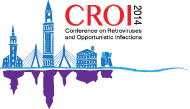Scientific Advances on the HIV Care Continuum Presented at CROI
Topics
 Among the scientific advances highlighted at the 21st Conference of Retroviruses and Opportunistic Infections (CROI)Exit Disclaimer in Boston, Massachusetts this week were a number of new studies addressing the provision of essential care to persons living with HIV infection, including diagnosis, linkage and retention in care, initiation of antiretroviral treatment (ART), and achievement of durable viral suppression. The timing of conference symposia and posters is particularly apt given efforts underway by federal agencies to undertake activities pursuant to the 2013 White House Executive Order to accelerate improvements in prevention and care by understanding and addressing gaps in the HIV care continuum (HCC).
Among the scientific advances highlighted at the 21st Conference of Retroviruses and Opportunistic Infections (CROI)Exit Disclaimer in Boston, Massachusetts this week were a number of new studies addressing the provision of essential care to persons living with HIV infection, including diagnosis, linkage and retention in care, initiation of antiretroviral treatment (ART), and achievement of durable viral suppression. The timing of conference symposia and posters is particularly apt given efforts underway by federal agencies to undertake activities pursuant to the 2013 White House Executive Order to accelerate improvements in prevention and care by understanding and addressing gaps in the HIV care continuum (HCC).
Improving Outcomes in the U.S.
The HCC offers a useful framework for evaluating and optimizing coordinated responses to the U.S. HIV epidemic, as called for by the National HIV/AIDS Strategy. For example, a study presented at CROI from Washington, D.C. using a large urban cohort of HIV-infected persons showed that although most were able to achieve durable viral suppression, health disparities in rates of viral suppression emerged with respect to race, sex, social and economic factors (Castel et al., 2014, Abstract #993). Similarly, a nationally-representative study conducted in the U.S. found no difference between prescription of ART for foreign-born and native-born persons in medical care; however, within-group differences among foreign-born persons suggested that improvements in resource allocation are needed to ensure access to ART and achievement of viral suppression, particularly among Caribbean migrants (Myers et al., 2014, Abstract #989).
Similarly, a study of HIV care continuum outcomes showed that New York City had stable rates of care engagement and retention but significant increases in viral suppression during 2006 – 2010, which was attributed to accurate case counting at the local level, comprehensive HIV lab test result reporting, improved access to affordable care, and widespread, rapid adoption of early ART by the city’s clinicians (Torian et al., 2014, Abstract #991). Further, an examination of the impact of new treatment guidelines and improvements in community viral load in the Bronx between 2007-2012 showed that implementation of earlier ART initiation was associated with improved viral loads among most groups but that more attention to the treatment needs of youth was indicated (Hanna et al., 2014, Abstract #995). These and other studies offer important clues for interventions to improve clinical care outcomes for persons living with HIV infection. In an innovative approach to integrating public health and clinical care consistent with a 2012 Institute of Medicine report, a feasibility study demonstrated that it was possible to utilize San Francisco Department of Public Heath surveillance data to successfully identify persons who have fallen out of care and attempt to re-engage them (Buchacz et al., 2014, Abstract #978).
A Useful Framework for International Settings
The value of the HCC framework was also apparent in studies shared at CROI examining treatment outcomes in low- and middle-income countries as well. For example, a cross-sectional, population incidence study suggested that high levels of viral suppression and low incidence can be achieved in high-prevalence settings in Malawi, which has implications for improving continuum outcomes (Maman et al., 2014, Abstract #992LB). In India, a study of engagement in HIV care among injecting drug users (IDU) and men who have sex with men (MSM) found low rates of HIV diagnoses among these high priority groups constituted a major barrier to improved care continuum outcomes. Further, the investigators suggested that bundling HIV testing with other essential services – particularly in areas with higher levels of HIV-associated stigma and discrimination – offered promise for resolving this impediment (Mehta et al., 2014, Abstract #1063).
Another study evaluated continuum outcomes in four African countries using an alternative cascade model and found that a modified HCC framework which incorporates pre-ART outcomes and timeframes provides a more comprehensive assessment of program outcomes than the standard HCC framework that does not use these data (McNairy et al., 2014, Abstract #151). A study in Zambia examined the non-linear pathway many persons take through the HCC, whereby persons living with HIV drop out of care and re-enter at a later date. They found that this dynamic is sufficiently common to warrant the development of interventions to prioritize and improve retention in care (Holmes et al., 2014). Indeed, a modeling study from South Africa estimated the impact of strategies to reduce attrition from the treatment continuum at each step and demonstrated that improving retention in care offers the greatest return in terms of life years preserved. The study further recommends the use of cost-effectiveness analyses to identify which interventions offer the best value for money in this regard (Cambiano et al., 2014, Abstract #1066).
In summary, CROI offered a large sample of recent studies that seek to improve the evaluation and optimization of HIV care continuum outcomes across a range of settings, many of which will be archived or otherwise made available at the conference websiteExit Disclaimer (see Scientific Program, then Electronic Materials). In future, greater attention will likely be devoted to improving sampling methods for estimates of attrition from the care continuum; understanding the heterogeneity of outcomes at the national, state, local, and clinic levels; and who best to target with what effective and cost-effective interventions to ensure that persons living with HIV accrue the full benefit of prevention, treatment, and care services.